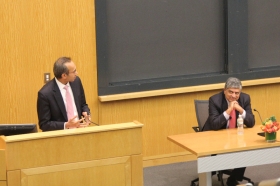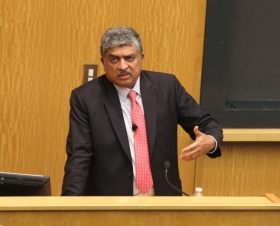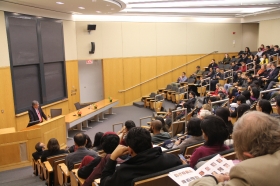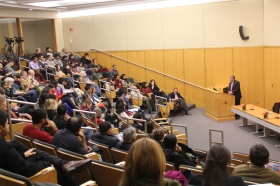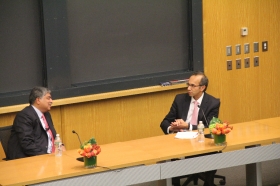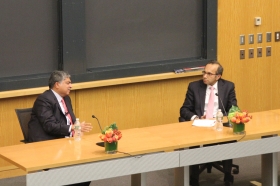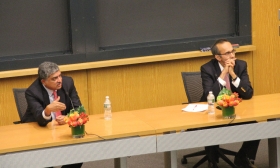By Siddarth Nagaraj, MALD Candidate, The Fletcher School of Law and Diplomacy,Tufts University
“Being able to confirm, in a robust and unequivocal way, who a person is” is vital to governance and social inclusion, and requires the creation of unique digital identity, said Nandan Nilekani, former Chairman of the Unique Identification Authority of India (UIDAI) at the South Asia Institute Annual Harish C. Mahindra Lecture on November 3, 2014.
During his tenure as chairman of UIDAI, Nilekani designed and implemented Aadhaar, a national biometric identification project wherein each Indian is issued a twelve-digit number that is unique to them.
In his lecture on Nov. 3, Nilekani discussed the personal and national benefits of Aadhaar, which he referred to as the “world’s largest social project.” His arguments in favor of the initiative gave the audience fascinating insight into the creation and structure of the world’s largest national identification system.
Nilekani was introduced by Tarun Khanna, Jorge Paulo Lemann Professor at Harvard Business School and Director of SAI. Prior to becoming chairman of UIDAI, Nilekani co-founded and later served as CEO of Infosys, India’s third largest IT services company. In 2009, at the invitation of Prime Minister Manmohan Singh, he left the private sector to lead UIDAI, where he created Aadhaar.
During the enrollment process, Aadhaar collects the name, address, gender, fingerprint and iris scan of each enrolled individual. Under Nilekani’s leadership, Aadhaar enrolled 700 million Indians in five years and he has continued to advocate on its behalf, arguing that digital identity is essential not only for oversight and accountability, but also for social inclusion and personal empowerment.

When explaining Aadhaar’s importance, Nilekani emphasized both the need for digital identity in the modern era and the multiple applications of the project’s ID. The government’s interest in Aadhaar originated from a desire to identify fraud that is perpetrated easily in the absence of clear, unique identity status.
Nilekani noted that Aadhaar has been successful in this area, but also strongly stressed the project’s potential to expand social inclusion. In Nilekani’s view, providing individuals with Aadhaar gives them an exclusive proof of their identity that is unique to them and cannot be misappropriated. This makes it easier to collect benefits, preserve public and medical records, and protects a basic right to sole possession of one’s own identity.
Nilekani posited that Aadhaar has created a foundation from which Indians who previously held no exclusive identification can engage in more legitimate “small-level interactions” such as opening and using bank accounts that collectively contribute to productivity. By doing so, they embed themselves in society and the economy more securely.
During the lecture, Nilekani also identified several critical challenges that he and his team faced when designing Aadhaar. Although the initiative had government support, its long-term viability depended on immediate, irreversible implementation. Accordingly, the UIDAI set an enrollment target of 600 million people (which they surpassed significantly) and issued IDs at a pace that was rapid enough to give an increasing number of Indians access to Aadhaar’s benefits while moving the project to a point where it would be too large and heavily embedded for its critics to easily eliminate it.
It was also essential that Nilekani and his team maintain direct control over Aadhaar, which served a unique purpose, but would have been severely undermined if forced to coordinate with other ministries’ priorities. Instead, the Prime Minister granted Nilekani autonomy in leading the UIDAI, giving him freedom to shape Aadhaar as best suited to the project’s purpose.
Perhaps the most significant challenges facing Aadhaar’s creators were linked to issues of scalability. Nilekani observed that many critics have focused great attention upon Aadhaar’s unparalleled target population size (now extended to all Indians), but he explained that UIDAI’s commitment to designing scale properly early on resulted in successful enrollment of smaller but nonetheless daunting and then-unprecedented numbers of people, something that skeptics had considered unfeasible.
Nilekani noted that some opponents of Aadhaar regard plans to enroll every Indian as being excessive, but countered that not only should enrollment be fully inclusive, but that the character and amount of data collected by Aadhaar is deliberately limited. This was due to a deliberate choice to place specific constraints on types of relevant data collected so that scalability would be optimized.
Aadhaar was carefully designed to serve a very specific purpose, and in order to achieve that on such a massive scale, the UIDAI team utilized an intriguingly minimalist approach that focused data collection upon what is purely essential (name, gender, address) and unique (iris scan, fingerprint).
Following the lecture, Nilekani took time to answer questions from the audience, commenting that numerous policymakers from several states have consulted with UIDAI with regard to adopting the Aadhaar model elsewhere. Stressing Aadhaar’s minimalist character, he encouraged social entrepreneurs to seek simple solutions when addressing scalability.
Concluding the event, Nilekani directly addressed those who remained wary of the scale of Aadhaar’s work, reminding the audience of the much greater extent to which Internet companies collect personal data for their own ends: “Fear Amazon, not Aadhaar.”
Reactions from Twitter:
Good to hear @NandanNilekani be nuanced re. e-voting: ok for eligibility, not voting: concerns re. #anonymity being compromised #SAIMahindra
— Malavika Jayaram (@MalJayaram) November 4, 2014
“You can’t solve the citizenship problem without the solving the identification problem.” @NandanNilekani @HarvardSAI
— Divya (@dso713) November 3, 2014
.@NandanNilekani Very minimal set of fields collected. Also remember, people *want* to be included and seen. #SAIMahindra
— Malavika Jayaram (@MalJayaram) November 4, 2014
“children’s height and weight captured in real time” — @NandanNilekani possibility for biometric ID uses in healthcare #saimahindra
— Laura Neuhaus (@promethea) November 3, 2014
Great to have @NandanNilekani at @Harvard today courtesy @HarvardSAI pic.twitter.com/KZuYTIYaOB
— Kunal Lunawat (@KunalLunawat) November 3, 2014
@NandanNilekani @HarvardSAI Aadhaar was designed to be too big to be reversed!
— Nikhil Jaipuria (@nikhiljaipuria) November 3, 2014
Attending the Annual Mahindra Lecture at Harvard University about the Digital Ecosystem in India. pic.twitter.com/nzIu1tf1WM
— Arvind Gupta (@buzzindelhi) November 3, 2014
Delighted that my friend Nandan is delivering the Harish Mahindra lecture at Harvard this evening… http://t.co/LaqgzGQHUh
— anand mahindra (@anandmahindra) November 3, 2014
Great to have @NandanNilekani at @Harvard today courtesy @HarvardSAI pic.twitter.com/KZuYTIYaOB
— Kunal Lunawat (@KunalLunawat) November 3, 2014
VIDEO:



